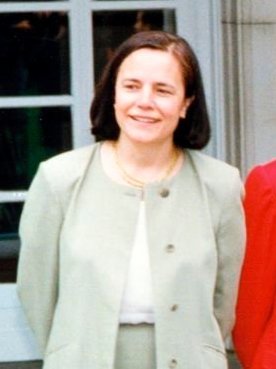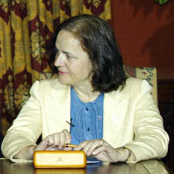Loyola de Palacio facts for kids
Quick facts for kids
The Most Excellent
Loyola de Palacio
|
|
|---|---|

de Palacio in 1996
|
|
| Minister of Agriculture and Fisheries | |
| In office 6 May 1996 – 30 April 1999 |
|
| Monarch | H.M. Don Juan Carlos I |
| Prime Minister | José María Aznar López |
| Preceded by | Luis María Atienza |
| Succeeded by | Jesús Posada |
| Member of the Senate | |
| In office 22 June 1986 – 28 October 1989 |
|
| Constituency | Segovia |
| Member of the Congress of Deputies | |
| In office 28 October 1989 – 17 July 1999 |
|
| Constituency | Segovia |
| Vice-President of the European Commission European Commissioner for Parliamentary Relations, Transport and Energy |
|
| In office 16 September 1999 – 21 November 2004 |
|
| President | Romano Prodi |
| Preceded by | Erkki Liikanen (Parliamentary Relations) Neil Kinnock (Transport) Christos Papoutsis (Energy) |
| Succeeded by | Siim Kallas (Parliamentary Relations) Jacques Barrot (Transport) Andris Piebalgs (Energy) |
| Personal details | |
| Born |
Ignacia de Loyola de Palacio y del Valle Lersundi
16 September 1950 Madrid, Spain |
| Died | 13 December 2006 (aged 56) Madrid, Spain |
| Political party | People's Party |
Loyola de Palacio (born Ignacia de Loyola de Palacio y del Valle Lersundi; 16 September 1950 – 13 December 2006) was an important Spanish politician. She was one of the first women to become a top leader in Spain. This happened during the early years when Spain was becoming a democracy again. She served as a minister in the Spanish government from 1996 to 1998. Later, she was a member of the European Commission from 1999 to 2004.
Contents
Early Life and Education
Loyola de Palacio was born in Madrid, Spain. Her family was an aristocratic Basque family. She was the oldest of four sisters and three brothers. Her mother passed away when Loyola was 22 years old. After that, Loyola helped take care of her family.
She went to school at the Lycée Français in Madrid. She studied law at Complutense University. She also studied Communications Engineering.
Political Career and Achievements
In 1976, Loyola de Palacio helped start a political party called Alianza Popular. This party later became the Partido Popular. She was the first leader of its youth group, called Nuevas Generaciones. Her political ideas were seen as liberal within her party.
In June 1986, she was elected to represent Segovia in the Senate. This is the upper house of the Spanish Parliament. She joined the national leadership of the Partido Popular in 1989. In October 1989, she was elected to the lower house, called the Congress of Deputies. She stayed in this role until 1999.
From 1996 to 1999, she served as the Minister of Agriculture, Fisheries and Food. She was part of José María Aznar's government.
In June 1999, Loyola de Palacio led her party's list in the European elections. She was elected to the European Parliament. On 13 September 1999, she also joined the European Commission. This is a group of leaders who help run the European Union. She became the Commissioner for Energy and Transport. She also served as a Vice-President of the Commission. In this role, she handled relations with the European Parliament.
She worked hard to develop the Galileo positioning system. This is a global satellite navigation system. She also pushed for new rules for safety at sea. This was especially important after the Prestige oil spill in 2002.
Life After Politics
After leaving the European Commission in November 2004, Loyola de Palacio joined the boards of some important companies. She became a director at the banks BNP Paribas and Rothschild Bank. She also worked for the pharmaceutical company Zeltia.
Personal Life and Legacy
Loyola de Palacio had a sister named Ana Palacio, who is also a well-known politician.
She was a devoted Roman Catholic. She enjoyed sports like mountaineering, but she especially loved diving and windsurfing.
In 2006, Loyola de Palacio was diagnosed with a serious illness. She received treatment in Houston and Madrid for five months. She passed away in Madrid on 13 December 2006. After her death, a special memorial was held. All political parties, even those who disagreed with her, came together to remember her work. They honored her efforts to improve rules and laws in the European Union.
Since 2008, the European Commission has honored her memory. They created a special program called the "Loyola de Palacio" European Policy Chair. This program is at the European University Institute in Italy.
See also
 In Spanish: Loyola de Palacio para niños
In Spanish: Loyola de Palacio para niños


